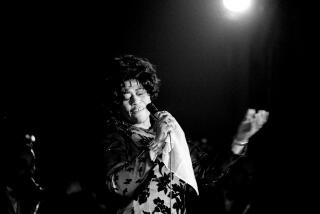David Byrne in all of his contexts
David Byrne is, to use one of his favorite words, a context unto himself. Founding member of Talking Heads, he blew up the concept of that band at least three times before disbanding it in 1988 for good.
By then, he was already a film director, artist and composer, working on projects such as Robert Wilson’s 1985 “The Knee Plays” and Twyla Tharp’s 1981 ballet “The Catherine Wheel.”
In the years since, he has created his own world music record label, written movie soundtracks and published half a dozen books. The most recent, “Bicycle Diaries,” is nothing less than the manifesto of a committed bicyclist. And this week he releases “Love This Giant,” a joint album with the singer-songwriter known as St. Vincent.
The idea of context is all over Byrne’s new book, “How Music Works” (McSweeney’s: 356 pp., $32), a musician’s memoir that is not a musician’s memoir but moves back and forth from the personal to more eclectic considerations: the various elements required to “make a scene” (appropriate venues, cheap rent, “a sense of alienation” from prevailing tastes in music) or the influence of technology on art.
“I didn’t want to write a memoir,” Byrne says by phone from his Manhattan office, voice firm but reedy, almost like his singing. “So I started thinking about music in a different way.” Rather than just tell the story of his own career, he preferred to see it as a path to something: a case study, an example of how to live the musician’s life.
Byrne wasn’t starting from scratch, exactly; he had some pieces, including the text of a Technology, Entertainment and Design (TED) conference that became the book’s first chapter, and as he began to fit these components together, a familiar pattern asserted itself.
Byrne, after all, has often built his projects through accretion, going back to his days in Talking Heads. In “How Music Works,” he describes how a technique of “‘incomplete’ recording” developed while working on the 1979 album “Fear of Music”: a process in which the band would lay down basic tracks and then embellish, Byrne improvising his lyrics to the groove.
“How Music Works” is something of a text equivalent of that, a collection of pieces that dovetail and overlap like the instruments in a song. It all grows out of that opening chapter, which asserts “that context largely determines what is written, painted, sculpted, sung, or performed.”
As an example, he cites CBGB, ground zero of the New York punk/new wave scene of the 1970s, the bar that nurtured the bands Television, the Ramones, Blondie and the Patti Smith Group, as well as Talking Heads. All of these musicians, Byrne suggests, wrote songs to fit that atmosphere, where “[p]eople drink, make new friends, shout, and fall down, so the performers had to play loud enough to be heard above that — and so it was, and is.”
This is what Byrne means when he says that “music is affected by all these different contexts” — that it must exist in, and respond to, the outside world. It is a public art, first and foremost, whether we encounter it via digital recordings or on the concert stage.
“It was a huge revelation,” Byrne says, finding a link between punk rock and more formal world traditions, “to see performances of Kabuki theater, or Balinese gamelan music, where people wandered in and out of shows. It was like seeing a show in a club — nobody minded — which led me to make connections between different styles of music and performance.”
There is, in other words, an interplay between performer and audience, a sense of the moment, that all music shares.
To underscore these and other relationships, Byrne pushes “How Music Works” into unexpected directions, including two chapters on the history of recording, and others that describe what happens in a studio as well as how the music business works.
He uses his own recordings as examples, at one point breaking down the numbers on his 2004 album “Grown Backwards,” for which he was paid an advance of $225,000.
“It gave my accountant pause,” he laughs. “He said, ‘You’re going to do what?’” But Byrne has always liked to push himself beyond his instincts — “don’t tell somebody what you make” — and here, he used the information to explain the economics of recording from the inside.
Yes, $225,000 sounds like a lot of money, yet Byrne spent all but $7,000 of it making the record; even after selling 127,000 albums, he walked away with $58,000 on the deal.
“Now $58,000 doesn’t sound too bad,” he writes. “That’s what an elementary teacher makes in New Jersey.”
It’s this brand of populism that is inspiring about “How Music Works,” which is never anything but accessible and direct. Among its primary arguments is one in favor of amateurism, which Byrne sees as essential to the art. “Music,” he enthuses, “is a way of getting together, and I think that’s going to grow.”
This may seem counterintuitive in an age of file-sharing, but for Byrne, it all feeds back to the same source.
“I have a strong sense,” he says, “that social communities online, shared devices, emailing tracks back and forth … this is great, and we’re not going to give it up, but it’s not a substitute for hanging out. As engulfed as we are in the digital world, there’s an impulse to live another way.”
At the heart of that, Byrne insists, is the ideal of collaboration, “another context that, when it works, takes part of the DNA of everyone involved, while becoming its own thing.”
This is the social component, the way music brings us together as performer and audience.
“It’s tricky,” Byrne admits, “because we have to give up some control. But what we get back is a balance that only exists when we play music, or go out and hear musicians play.”
More to Read
The biggest entertainment stories
Get our big stories about Hollywood, film, television, music, arts, culture and more right in your inbox as soon as they publish.
You may occasionally receive promotional content from the Los Angeles Times.







